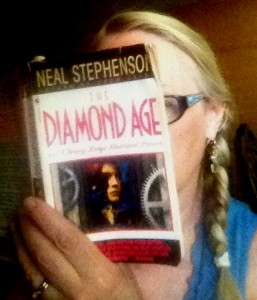Written back in 1995, I am finally getting around to reading Neal Stephenson’s The Diamond Age. Or, perhaps I should say I am finally ready for it. Twenty years ago, the idea of a technology entering our minds through virtual reality worlds and nanotechnology entering our bloodstreams to alter our bodies was over my head. Today, it is no longer far-fetched science fiction. Of course, like most people who have explored virtual worlds, I read Stephenson’s novel Snowcrash and credit him for coining the term “the metaverse”. Both novels share concepts that seemed almost outrageous when released but now fade into the tech scene without raised eyebrows.
While some of the concepts in The Diamond Age are similar to innovations which have come to fruition in 2013, some evolved into different versions of his visualized world. His “MC” (Matter Compiler) can be compared to a 3D printer and his concept of “ractive”s are similar to online interactive videogames.
The “young lady’s illustrated primer” is an interactive book which drives the plot and the concept of a real human behind the facade of the avatar or the book character is critical as we now move toward a blur between our physical and digital selves.
While I am no avid science fiction aficionado, I find Stephenson’s novels compelling and prophetic. Surprisingly, The Diamond Age contains countless images of actual physical books, yet today the book is moving from print into ereaders and rapidly taking a backseat to apps. Stephenson, obviously, has an appreciation for the Gutenberg era format, stating, “But a book is different–it is not just a material possession but the pathway to an enlightened mind, and thence to a well-ordered society as the Master has stated many times. (p.163)”
Long live the book and the reader who understands and appreciates high quality literature.

Stephenson, Neal. 1995. The Diamond Age or A Young Lady’s Illustrated Primer. Bantam Nooks: New York.